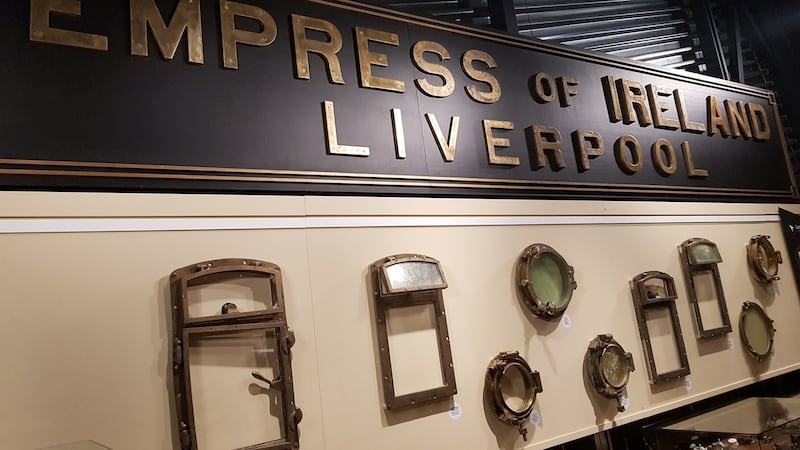While Louth man William Clark stoked the boiler-room fires on the Canadian luxury transatlantic liner the Empress of Ireland in May 1914, he must have wondered about the mathematics of odds and probabilities when the Norwegian collier the Storstad crashed into the Empress's hull.
Clark had survived the sinking of the Titanic. Two years later there he was again, doing the same poorly paid work and plunged suddenly into panic and chaos as a second ship celebrated for her engineering and opulence foundered in icy waters, this time in Canada's St Lawrence River.
The Storstad struck just before 2am on May 29th in thick fog following a signalling misunderstanding between the two ships. Although the Empress was equipped with watertight compartments and, with lessons learned from the Titanic disaster, carried more than enough lifeboats for all 1,477 passengers and crew, she sank in 14 minutes with the loss of 1,012 lives. She was only a day into her 96th voyage between Québec City and Liverpool. The Storstad remained afloat.
With the first World War brewing in Europe, the sinking of the Empress – the second-worst marine calamity of the time following the loss of 1,503 lives on the Titanic – faded into obscurity.
Clark ended up in the water but was pulled into a lifeboat and lived to tell the story of his second escape from death at sea which, combined with his survival of the Boer War, enhanced his reputation as a charmed Irishman. "The Empress rolled over like a hog in a ditch," he reportedly said. His and other accounts by survivors, witnesses and their descendants have kept memories of the catastrophe alive, and are preserved at the Empress of Ireland Museum at Pointe-au-Père in Rimouski, Québec, near where the wreck lies at the bottom of the St Lawrence.
Of 138 children on board, four survived. A tiny wallet displayed at the museum was found in the hands of nine-year-old Dolly Brooks. She had been travelling with her parents, her father one of a Salvation Army Band group on their way to a conference in England. Mrs Brooks held Dolly's hand until they hit the water. She was rescued and reunited with her husband, without Dolly.
Fog whistles
Seaman Thomas Corrigan, born in 1871 in Dundalk, also features. He spent much of his life working on ships sailing out of Liverpool. A strong swimmer, the father of five reportedly drowned after saving the life of a neighbour from Liverpool.
The Empress was built in Glasgow in 1906 for Canadian Pacific Railway. While her luxuriousness and spaciousness set her apart from her competition on the St Lawrence, her most distinctive feature was speed: the crossing took only two days on the river and four days at sea.
Navigating the St Lawrence is notoriously risky, and the fog made conditions worse. Captain Henry George Kendall of the Empress and the Storstad's chief officer Alfred Toftenes used their fog whistles to signal their manoeuvres, but they had difficulties making out each other's position.

Kendall later told an official inquiry, headed by Lord Mersey who had had presided over the Titanic investigation: "When the ships collided, I called out to the Storstad to maintain full speed ahead in order to plug the hole caused by the collision, but she reversed." One of the conclusions was that Toftenes was guilty of negligence. He was also blamed for not waking Storstad captain Thomas Andersen.
A parallel Norwegian inquiry blamed Kendall for failing to pass the Storstad port to port.
Champagne bottles
Divers worked to recover bodies, mail and silver bars worth more than $1 million. The wreck was then forgotten for 50 years. Private diving expeditions from 1964 on saw the recovery of thousands more items, including teak planks, signs, hundreds of intact bottles of champagne and wine, and the bugle that announced mealtimes. Some are displayed at the museum. Surprisingly, these expeditions were banned only in 1999, when Québec’s culture ministry classified the wreck as historical and archaeological property.
During the first World War, Kendall and Andersen had their boats torpedoed. Both survived. Andersen was still at the helm of the Storstad, Kendall on the British Royal Navy's Calgarian. In a letter Kendall recounted his luck:
"Well you noticed that the Calgarian was blown up . . . They put no less than four torpedoes into her so you can imagine the explosion and people being blown sky high . . . Well I was eventually saved with 150 others by another vessel. Now comes the fun! Half an hour after she was blown up, so down went Henry George again. However I managed to get to a drifting lifeboat and came to the conclusion it was good enough for me so eventually landed in Ireland."
Kendall died in London in 1965, aged 91.

















